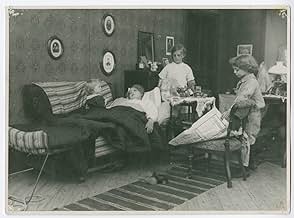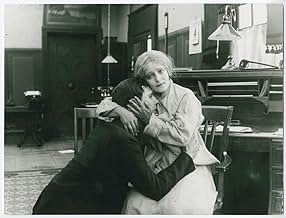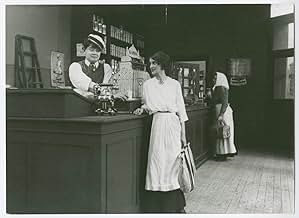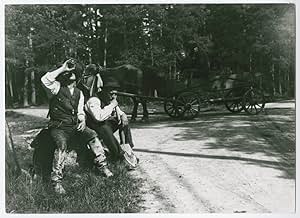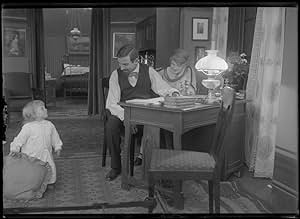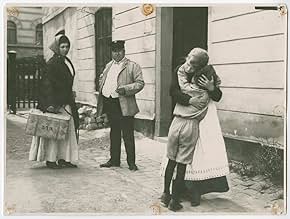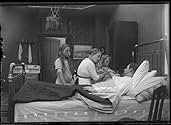IMDb-BEWERTUNG
7,0/10
1551
IHRE BEWERTUNG
Füge eine Handlung in deiner Sprache hinzuFinancial struggles separate a single mother from her children.Financial struggles separate a single mother from her children.Financial struggles separate a single mother from her children.
- Regie
- Drehbuch
- Hauptbesetzung
Empfohlene Bewertungen
A woman loses her husband and children in quick succession as the hand of fate lands her a tragic blow. Good direction, cinematography and acting for the time make this one of the essential silents and a standout in Scandinavian and world cinema. A must for fans of film history and movies in general.
Beautiful background music added to this Swedish silent film from 1913. This is first silent film I've seen and I didn't know what to expect. To my surprise, I was able to stay engaged for the full 73 mins and ended up enjoying the style in which the film is presented. The story of a widowed mother tugs at your heartstrings and is a bold commentary on the treatment of lower-class individuals (particularly women) at the time. Would recommend this film to anyone interested in deepening their understanding of European film from the early 20th century. I would not recommend this film to anyone looking to tune out to a relaxing (somewhat short) film.
Again, this is an early not-that-bad drama from Sjostrom about a person driven mad by tragic circumstances. It has a nice sense of restraint, especially for its era, with a fine performance by Hilda Borgstrom and a well-paced story. Nothing about the movie sucks. It just takes a little something extra for me to get involved with a silent film... some sort of avant-garde twist or dazzling technique or some thrilling action. Yeah, it's a good plot with a sympathetic protagonist, but my heart just wasn't in it. I can't imagine anyone besides a Sjostrom scholar watching this more than once.
6/10
6/10
The classic narrative films so familiar in "The Golden Age of Hollywood" movies had its beginning in October 1913 with Sweden's "Ingeborg Holm." Writer/director Victor Sjostrom adapted the Nils Krok 1906 play about a family who sinks to the depths of poverty after the father dies just as he assumes ownership of a store.
What sets "Ingeborg Holm" apart from the movies produced previously to the autumn of 1913 was the breath of its plot. Instead of taking a slice of a full-scale biography of the characters and producing a film on one particular stand alone event, here Sjostrom portrays an entire family's history, beginning when the head of the household receives bank funding to begin his enterprise. He continues the plot until years later, concluding in an emotional reunion with the mother and her long-absent son.
"Ingeborg Holm" fits all the criteria in cinema's full narrative definitions. A classic narrative begins by introducing all the characters who will propel the plot forward, just as Sjostrom illustrated with the comfortable middle-class family embarking on its new enterprise. Narratives contain a triggering event which shakes things up. Here, the father dies and his assistant at the store rips off the family's profits. Sjostrom continues the narrative plot by showing the mother-led family sinking into poverty, with the kids shunt off to the poor house. Events lead up to the conclusion, where the director visually reveals Sweden's lack of a safety net for the country's poor caused by, through no fault of themselves, their hardships.
Hollywood would follow Sjostrom's pattern of full narrative movies, especially during its classic 1930's--1950's golden age. There are variations of the narrative pattern in movies today, but the Swedes were the first to put into practice on film what literature and drama had been delivering for centuries.
Today's movie viewers may be familiar with Sjostrom by his last appearance on the screen in Ingmar Bergman's 1957's "Wild Strawberries," where he had the leading role of an aging professor who rediscovers his past through a journey to receive a honorarium.
What sets "Ingeborg Holm" apart from the movies produced previously to the autumn of 1913 was the breath of its plot. Instead of taking a slice of a full-scale biography of the characters and producing a film on one particular stand alone event, here Sjostrom portrays an entire family's history, beginning when the head of the household receives bank funding to begin his enterprise. He continues the plot until years later, concluding in an emotional reunion with the mother and her long-absent son.
"Ingeborg Holm" fits all the criteria in cinema's full narrative definitions. A classic narrative begins by introducing all the characters who will propel the plot forward, just as Sjostrom illustrated with the comfortable middle-class family embarking on its new enterprise. Narratives contain a triggering event which shakes things up. Here, the father dies and his assistant at the store rips off the family's profits. Sjostrom continues the narrative plot by showing the mother-led family sinking into poverty, with the kids shunt off to the poor house. Events lead up to the conclusion, where the director visually reveals Sweden's lack of a safety net for the country's poor caused by, through no fault of themselves, their hardships.
Hollywood would follow Sjostrom's pattern of full narrative movies, especially during its classic 1930's--1950's golden age. There are variations of the narrative pattern in movies today, but the Swedes were the first to put into practice on film what literature and drama had been delivering for centuries.
Today's movie viewers may be familiar with Sjostrom by his last appearance on the screen in Ingmar Bergman's 1957's "Wild Strawberries," where he had the leading role of an aging professor who rediscovers his past through a journey to receive a honorarium.
In conjunction with its release of THE OUTLAW AND HIS WIFE, Kino has also given us this splendid double bill from Victor Sjostrom (Seastrom in America) who was truly one of the world's great directors. His influence on other Scandinavian filmmakers (Ingmar Bergman and Carl Theodor Dreyer to name two of the best known) is clearly evident although with INGEBORG HOLM (1913) you could say he influenced many others as well. This film is incredibly well made for a film of its vintage. Although the camerawork is first rate it's the restrained naturalistic style of the acting by star Hilda Borgstrom along with the seriousness of the thematic material that really makes you sit up and take notice.
D. W. Griffith had explored social themes in his Biograph shorts before this but never in a feature length film and similar socially concious movies like TRAFFIC IN SOULS (also 1913) were not as dramatically sophisticated. The story of a widow whose husband leaves her bankrupt and is forced to live in a workhouse where she must give up her children to foster parents, works as both social indictment and dramatic tragedy. It's hard to watch this film and not become emotionally involved in the plight of the title character. The score by David Drazin is simple but effective using primarily piano with a few synthesized strings.
The other film on the disc, A MAN THERE WAS, dates from 1917 and is based on an epic poem (TERJE VIGEN) from the great Norwegian dramatist Henrik Ibsen (PEER GYNT). The English title cards are even an approximation of his poetic writing style which may be tough going for some but they add quite a bit to the visual narrative. Full of lots of natural location shooting including the open sea, MAN explores a variety of powerful emotions as a fisherman during the Napoleonic Wars is wrongfully imprisoned which results in the death of his family.
Many years after his release he is presented with the opportunity of saving the family of the man who sent him to prison. Donald Sosin's piano score is very effective especially during the sea sequences but it would have been nice to have a chamber or orchestral score to accompany the film. Nevertheless this is an important set from one of the great early film pioneers and as such should not be missed...For more reviews visit The Capsule Critic.
D. W. Griffith had explored social themes in his Biograph shorts before this but never in a feature length film and similar socially concious movies like TRAFFIC IN SOULS (also 1913) were not as dramatically sophisticated. The story of a widow whose husband leaves her bankrupt and is forced to live in a workhouse where she must give up her children to foster parents, works as both social indictment and dramatic tragedy. It's hard to watch this film and not become emotionally involved in the plight of the title character. The score by David Drazin is simple but effective using primarily piano with a few synthesized strings.
The other film on the disc, A MAN THERE WAS, dates from 1917 and is based on an epic poem (TERJE VIGEN) from the great Norwegian dramatist Henrik Ibsen (PEER GYNT). The English title cards are even an approximation of his poetic writing style which may be tough going for some but they add quite a bit to the visual narrative. Full of lots of natural location shooting including the open sea, MAN explores a variety of powerful emotions as a fisherman during the Napoleonic Wars is wrongfully imprisoned which results in the death of his family.
Many years after his release he is presented with the opportunity of saving the family of the man who sent him to prison. Donald Sosin's piano score is very effective especially during the sea sequences but it would have been nice to have a chamber or orchestral score to accompany the film. Nevertheless this is an important set from one of the great early film pioneers and as such should not be missed...For more reviews visit The Capsule Critic.
Wusstest du schon
- WissenswertesNoted as the first true narrative film, its remarkable narrative continuity would characterize the style now known as classical Hollywood, which dominated the global film industry for the majority of the century.
- VerbindungenFeatured in Victor Sjöström - ett porträtt av Gösta Werner (1981)
Top-Auswahl
Melde dich zum Bewerten an und greife auf die Watchlist für personalisierte Empfehlungen zu.
Details
- Laufzeit
- 1 Std. 36 Min.(96 min)
- Sound-Mix
- Seitenverhältnis
- 1.33 : 1
Zu dieser Seite beitragen
Bearbeitung vorschlagen oder fehlenden Inhalt hinzufügen

